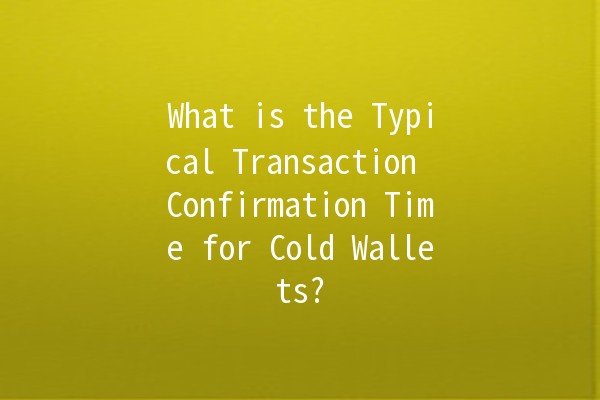




Cold wallets, also known as cold storage, are a crucial component in the realm of cryptocurrency. They provide a secure method for storing digital assets offline, protecting them from the risks of online threats such as hacking and phishing. Unlike hot wallets, which are connected to the internet, cold wallets store private keys in a completely offline environment.

As more people venture into the world of cryptocurrency, understanding the transaction confirmation time associated with cold wallets becomes increasingly vital. This knowledge not only aids users in managing their expectations but also helps them make informed decisions when engaging in cryptocurrency transactions.
Transaction confirmation time is the duration it takes for a blockchain network to verify a transaction. In the context of cold wallets, users first create a transaction in their cold storage, which is then signed and subsequently broadcasted to the network through a hot wallet or a connected device.
Here are the average transaction confirmation times for popular blockchains:
Bitcoin: Approximately 10 minutes.
Ethereum: Roughly 15 seconds to 5 minutes.
Litecoin: About 2.5 minutes.
Ripple (XRP): Close to 4 seconds.
Understanding the confirmation times is crucial for users when planning to trade, invest, or use cryptocurrency for transactions. A longer confirmation time can lead to delays in asset accessibility or potential price changes in volatile markets.
Here are five practical tips to improve your transaction experience and insight into managing confirmation times effectively:
Engaging in transactions during offpeak hours can lead to quicker confirmations since fewer trades are being processed by the network.
If you know a particular blockchain tends to be congested after significant news events or during peak trading sessions, plan your transactions during quieter periods. Monitor network congestion tools that provide realtime data on transaction volumes.
Setting a transaction fee that is competitive may help your transaction get prioritized by miners.
For Bitcoin, you can utilize fee estimation tools to see current market fees and adjust yours accordingly. If the average fee is 100 satoshis/byte, setting your fee slightly higher could increase the chances of faster confirmation.
Utilizing monitoring tools can give you insights into the network status, including current congestion levels.
Websites like Blockchair or Etherscan provide realtime information on block confirmation times and transaction volumes. Use these resources to time your transactions better.
Layer 2 solutions, such as the Lightning Network for Bitcoin or Optimistic Rollups for Ethereum, increase transaction speeds by processing them off the main blockchain.
If you frequently transact with Bitcoin, consider utilizing the Lightning Network for instant transactions, avoiding the delays of the main chain.
Keeping your wallet software updated ensures that you benefit from improvements and efficiency enhancements regarding transaction handling.
If you are using a cold wallet interface that connects to your hot wallet, make sure both are updated regularly. New updates may include optimization features that enhance the transaction process.
Transaction confirmation time is influenced by several factors, including network congestion, transaction fees set by the user, and the underlying blockchain technology. During periods of high traffic, transactions can take longer to confirm, while higher fees often lead to prioritization by miners or validators.
A cold wallet itself does not speed up or slow down transaction confirmations. However, since transactions initiated from a cold wallet need to be broadcasted through a connected device, the waiting time to confirm the transaction on the blockchain is what users need to consider. The actual speed is determined by the network conditions and transaction fees.
Once a transaction is submitted to the blockchain, it cannot be expedited directly. However, if it remains unconfirmed for an extended period, users can utilize certain wallets that offer a “ReplacebyFee” feature, enabling them to resend the transaction with a higher fee.
While cold wallets offer enhanced security by keeping private keys offline, they are not entirely riskfree during transactions. Users should ensure they securely sign transactions in a safe environment and always doublecheck recipient addresses to prevent fraudulent actions.
You can check the confirmation status of your transaction by using a block explorer specific to the cryptocurrency being transacted. By entering the transaction hash, users can view its status, including the number of confirmations achieved.
There is no strict minimum transaction fee, but lower fees can result in extended confirmation times, especially in periods of network congestion. It’s advisable to stay updated on current average fees to ensure timely processing of your transactions.
Understanding transaction confirmation times for cold wallets is essential for managing your cryptocurrency effectively. By following the tips outlined and considering the factors influencing transaction speed, you can optimize your experience and ensure smoother transactions. Investments in cold storage security and strategic planning can significantly enhance the efficiency of your digital asset management, providing peace of mind in a rapidly evolving financial landscape.